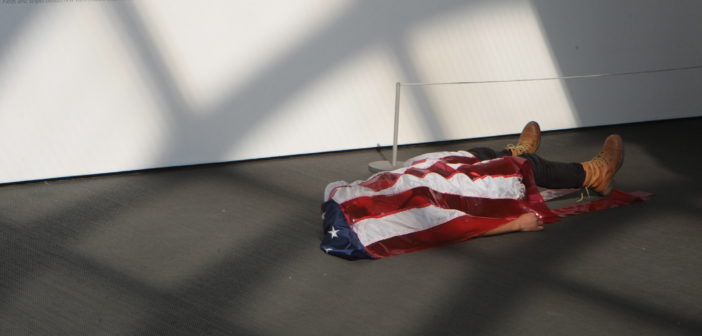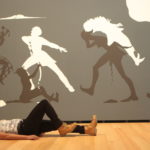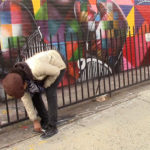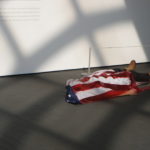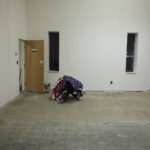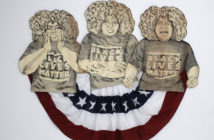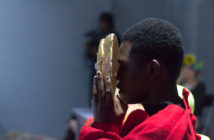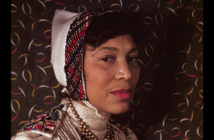Inside/Out is Big Red & Shiny's artist-in-residence series, offering a space for artists to write about their ideas, research, and challenges, and publish their inspirations, obsessions, creative experiences, and insights. Unlike an 'Open Studio' format, which is often predicated on potential sales, BR&S wants to provide the artist-in-residence with an outlet to place their practice in a more public realm, offering an expanded look at the creative process and placing emphasis on the time ideas and works take to mature. It is not expected that the artist produces anything finished or specific to BR&S in this time, only that they candidly share their explorations.
Our current artist-in-residence is Dell M. Hamilton, who works in a myriad of mediums to overturn traditional conceptions of gender, race, and history. While the breadth of her artistic practice includes performance, video, installation, photography, and drawing, she is also a lecturer, curator, and contributor to Transition, a publication produced by the Hutchins Center for African & African American Research at Harvard University. As the artist explains, "It is my deepest desire to holistically question and to identify the location of where the self begins and ends, and to wrestle with the socio-cultural and psychic implications of collective existence and interdependence." In grappling with the past, her work confronts the reality of the present and exposes possibilities for the future. In her first post, Hamilton reflects on the results of the 2016 presidential election and its political, social, and personal consequences.
And yes, the inaudible spreads across state lines.
Its call backing away from the face of America.
Bloodshot eyes calling on America
that can’t look forward for being called back.
-Claudia Rankine, Citizen, An American Lyric (2014)
Confidence is over-rated. Give doubt a try.
-Anna Deavere Smith
It’s called the American Dream, because you have to be asleep to believe in it.
-George Carlin
Earlier this month, I celebrated a birthday with many new and old friends. I reveled in the joy of being surrounded & supported. But along with this ritual celebration of birth & life, I can’t help but reflect upon a year that has been shaped by the deaths of both family & friends.
I am grappling with the reality that while I am still here in the world, I deeply feel their absences, and I am left with my anger, grief, guilt, denial & confusion. Even as I type these words, I realize that these emotions are supposed to be a part of the process: “The Five Stages of Grief.”
Except that I’m an artist—I’m supposed to be exceptional and different. And yet I am so ordinary & predictable. That I am so utterly limited in my capacity to understand the how and the why of death has shocked my ability to understand what I thought I knew.
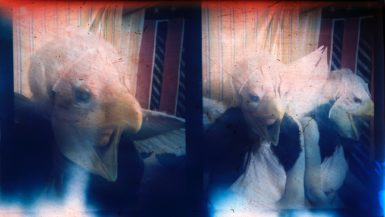
“Mecca” from the series Fallen Angels – Making Sense Out of Nothing, 2014-2016, (Medium format color film, unique digital scan, 24 inches x 39 inches)
What’s also made my contemplation of birth, death and life even more complicated is that for months this emotional turbulence was amplified by the surreal nature of the 2016 presidential election.
Full disclaimer: I voted for Bernie Sanders in the 2016 Massachusetts presidential primary and voted for Hillary Clinton on November 8th. President Obama was elected on my birthday in 2008 and then again on my youngest brother’s birthday in 2012. I also volunteered and campaigned on behalf of Marty Walsh’s successful Boston mayoral bid in 2013.
To put it plainly, I am a political junkie. I enjoy going to rallies & election parties, knocking on doors, signing petitions, and tweeting about the debates.
In retrospect, I admit that I too thought that the #shortfingeredvulgarian was simply orchestrating an elaborate but short-lived publicity stunt. But by the end of last summer, I began to contend with the possibility that Trumpism could prevail.
What I also began to speculate about was that his campaign style was a new genre of political theater that had roots in the outrageous showmanship of P.T. Barnum. That Trump has so astutely performed himself and manipulated audiences via our collective addiction to mobile media & televisual phenomena has been years in the making.
Scholar Christopher Robichaud articulated just such a strategy in a Harvard Gazette article on “post-truth” politics earlier this year:
“This has just been a clinic on the post-truth age of politics, Trump in particular. It’s performance art at this point. It’s true that what Trump is saying is false, it’s just that in the ‘post-truth’ age of politics, we’re beyond criticizing someone for that. It’s like criticizing an actor for saying a lot of false things. He says whatever he needs to say to move people emotionally.”
And yet I couldn’t stop watching.
Back in 2005, Stephen Colbert presciently coined the term truthiness on the pilot episode of his political satire show The Colbert Report, which I think also speaks to this concept of “post-truth.” This clip is especially poignant as I continue to wrestle with death, loss & complicity in all of its guises (literally, metaphorically, socially and politically).
So while I take seriously the entangled relationships, theoretical frameworks and practical distinctions between reality TV, acting & live art, watching the campaign unfold has been both fascinating & frightening in that it has crystallized how the performance of politics mediates optics and our social perceptions of reality, truth & each other.
If I rationalize my internal conflicts in the wake of the election and count my blessings, I acknowledge that I’m an American-born artist whose family emigrated from Honduras (which experienced a coup as recently as 2009). I’ve also been making work for some time about the impact of slavery, colonization, violence, & American imperialism on Honduras and the deception of "The American Dream" and what Colin Crouch calls “post-democracy.”
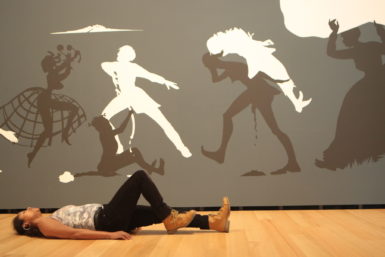
C.D.B. (Columbus Day Blues), October 14, 2013, 2-hour roving performance, Museum of Fine Arts/Boston, Photo credit: Terrence Jennings
So it would seem that the privilege of being able to make art about these concepts, as well as being able to cast my vote and organize as a result of the heroic sacrifices made during the Civil Rights Movement, is/was exactly what I should do. Except that now everything has changed and I have no reason to believe in the lyrics of Kendrick Lamar’s “We Gon’ Be Alright.”
In the early morning of November 9th, the President-elect said during his victory speech:
“Now it’s time for America to bind the wounds of division; have to get together. To all Republicans and Democrats and independents across this nation, I say it is time for us to come together as one united people. It’s time. I pledge to every citizen of our land that I will be president for all Americans, and this is so important to me.”
But how precisely does that happen given all that we experienced and witnessed over the past 18 months?
What do I do with the realities of anti-blackness that have been weaponized for centuries across the globe and codified and embodied by the President-elect and his followers and that undoubtedly will be replicated and signified upon in elections to come?
Such internal dialogues hurtle me back to readings that I did in scholar Christina Sharpe’s class the Memory for Forgetting at Tufts University, in which I had to constantly ask myself: What does it mean to live with the afterlives of slavery and violence?
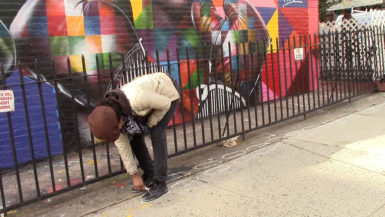
Where Else Williamsburg? Brooklyn, New York, Durational performance, 13 hours, 2014. Photo credit: David Griess
In her latest work, In the Wake: On Blackness and Being, Sharpe quotes the work of Joy James and Joao Costa Vargas, who ask: “What happens when instead of becoming enraged and shocked every time a Black person is killed in the United States, we recognize Black death as a predictable and constitutive aspect of this democracy?”(1)
And yet with all that I understand about Hillary Clinton’s problematic role as Secretary of State during the 2009 Honduran coup that overthrew Manuel Zelaya. Even with all that I comprehend about how deeply flawed she is as a politician. I wept during her concession speech and I weep for America.
How do I now make sense of a country whose present strauma (stress, trauma, & drama) is as anti-Semitic, anti-immigrant, anti-indigenous, Islamophobic, homophobic, oppressive, war-mongering and misogynistic as the one into which I have been born and willingly make art about? A country that has reshaped me in such a way that when esteemed South African Justice Edwin Cameron—who has lived through the oppression of apartheid and who now currently sits on their Constitutional Court—asks what on earth happened on November 8th, I have no plausible answer to offer.
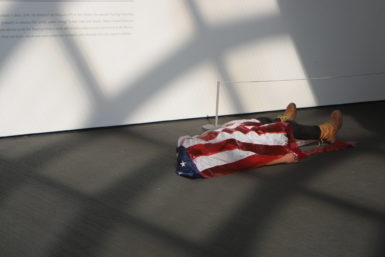
C.D.B. (Columbus Day Blues), October 14, 2013, 2-hour roving performance, Museum of Fine Arts/Boston. Photo credit: Terrence Jennings
It’s been said that as you age, you get wiser about who you are and what your path and purpose is, that you have clarity about how to put one foot in front of the other. But what is the register and measure of that purpose if, as political theorist Danielle Allen, who foresaw the possibilities of this election outcome many months ago, suggests that what happens next largely depends upon each of us?
In other words what did poet & activist Maya Angelou mean when she said, “I did then what I knew how to do. Now that I know better, I do better”?
As it stands, the “know better” that I can claim & understand at this moment is that there is no center, no intersection, no corner, no location, no ground and no horizon where the knowledge of anti-blackness, my grief over the loss of loved ones, and the shock of what happened during this election won’t have an effect on me.
What I “know better” is that with all of my resilience, artistry, activism, determination, faith, hope, gratitude, community and insistence upon simply living and being is that death & doubt are what I have to live with now.
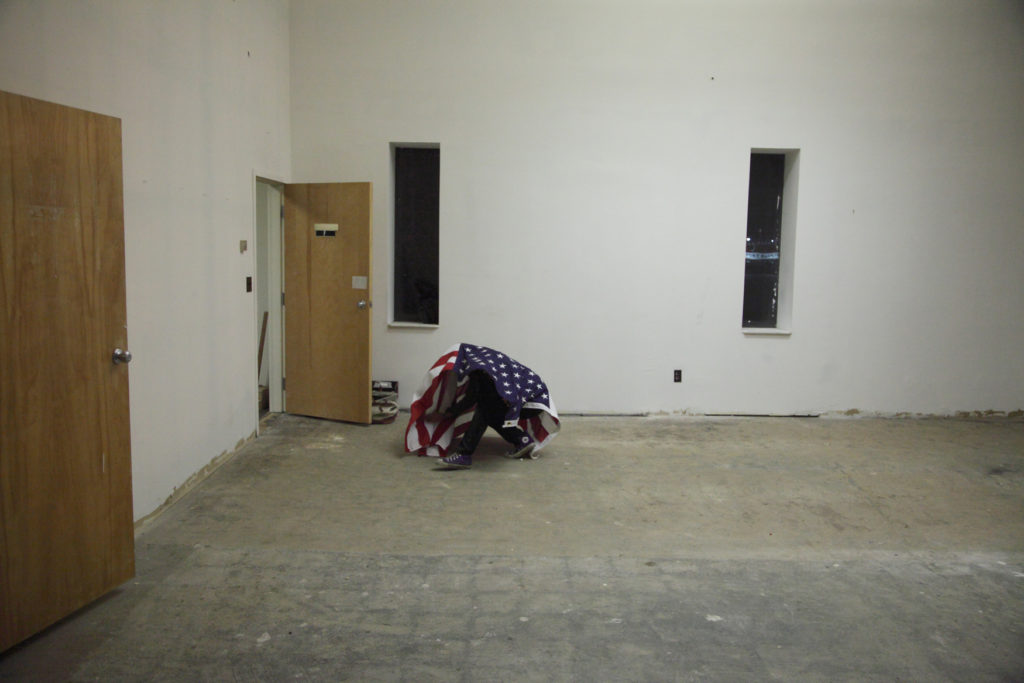
N.O.A. (Notions of America), 2010, Art Rages/Surreal Estate organized by Mobius. Photo credit: Bob Raymond
- Christina Sharpe, In the Wake: On Blackness and Being (Durham: Duke University Press, 2016) 7.
- “Mecca” from the series Fallen Angels – Making Sense Out of Nothing 2014-2016, (Medium format color film, unique digital scan, 24 inches x 39 inches)
- C.D.B. (Columbus Day Blues), October 14, 2013, 2-hour roving performance, Museum of Fine Arts/Boston, Photo credit: Terrence Jennings
- Where Else Williamsburg? Brooklyn, New York, Durational performance, 13 hours, 2014. Photo credit: David Griess
- C.D.B. (Columbus Day Blues), October 14, 2013, 2-hour roving performance, Museum of Fine Arts/Boston. Photo credit: Terrence Jennings
- N.O.A. (Notions of America), 2010, Art Rages/Surreal Estate organized by Mobius. Photo credit: Bob Raymond

